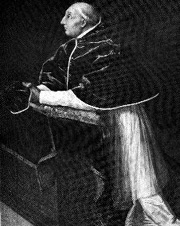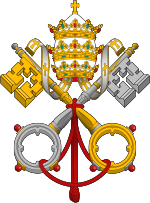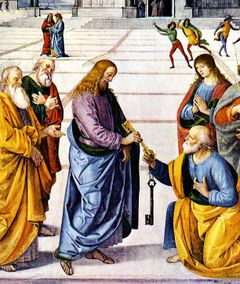Pope Martin V
| Martin V | |
|---|---|
 |
|
| Papacy began | November 11, 1417 |
| Papacy ended | February 20, 1431 |
| Predecessor | Gregory XII |
| Successor | Eugene IV |
| Personal details | |
| Birth name | Oddone Colonna |
| Born | c. 1368 Genazzano, near Rome, Papal States |
| Died | 20 February 1431 (aged 63) Rome, Papal States |
| Other Popes named Martin | |
| Papal styles of Pope Martin V |
|
|---|---|
 |
|
| Reference style | His Holiness |
| Spoken style | Your Holiness |
| Religious style | Holy Father |
| Posthumous style | None |
Pope Martin V (c. 1368 – February 20, 1431), born Odo (or Oddone) Colonna, was Pope from 1417 to 1431. His election effectively ended the Western Schism (1378–1417).
Contents |
Life
The son of Agapito Colonna and Caterina Conti, he belonged to one of the oldest and most distinguished families of Rome. His brother Giordano became Prince of Salerno and Duke of Venosa, while his sister Paola was shortly lady of Piombino in 1441–45.
He became apostolic protonotary under Pope Urban VI (1378–89), was created Cardinal Deacon by Pope Innocent VII (1404–06), and in 1410 was the delegate of antipope Alexander V (1409–10) to hear the appeal which had been taken in that year to the Papacy by Jan Hus. In 1390 he was elected bishop of Urbino, but resigned in 1409 before receiving episcopal consecration. He served also as archpriest of the Lateran Basilica from 1412.
He was elected pope on St. Martin's Day (November 11), 1417, at the Council of Constance by a conclave consisting of twenty-three cardinals and thirty delegates of the council, which after deposing antipope John XXIII (1410–15), had been for long divided by the conflicting discourses of Pope Gregory XII (1406–15) and antipope Benedict XIII (1394–1423).
Martin V was widely esteemed for moderation, learning, uprightness, and business ability, but he is not seen as a reforming Pope. His first act after his election was to publish a brief confirming all the regulations made by his predecessors regarding the papal chancery, regulations which had long been the subject of complaint. When the "nations" of the council pressed their plans for reform, Martin V submitted a counter scheme, and ultimately entered into negotiations for separate concordats, for the most part vague and illusory, with the Holy Roman Empire, England, and France.
With issuing the Papal Bull to exterminate Hussites, Wycliffites, and other heretics in Bohemia on March 1,[1] 1420, Martin V initiated the Hussite Wars.

He left Constance at the close of the council (May 1418), but travelled slowly through Italy, lingered at Florence, and did not venture to enter Rome until September 1420, when his first task was to seek to restore it to the prosperity and order to which it had become a stranger.
In that period, in 1418, a famous synod convoked by the Jews in Forlì, sent a deputation with costly gifts to the new pope, Martin V, praying him to abolish the oppressive laws promulgated by antipope Benedict XIII and to grant the Jews those privileges which had been accorded them under previous popes. The deputation succeeded in its mission.
In accordance with the decree of Constance, confirmed by himself, ordering that councils should be held every five years, in 1423 Martin V summoned the council which met at Pavia and afterwards at Siena (the Council of Siena)—it was rather poorly attended, and in this circumstance gave the pope a pretext for dissolving it as soon as it had come to the resolution that "internal church union by reform ought to take precedence over external union". It was prorogued for seven years, and then met at Basel (the Council of Basel); shortly after its opening Martin V died of apoplexy. He is buried in the confession of St. John Lateran's, the Pope's cathedral, in Rome. The introductory essay to Lumley's Treatise upon the Law of Annuities and Rent Charges, 1st ed, 1833, contains an interesting history of the use of annuities as a financing mechanism. The learned author points out that the general law prevailing throughout Europe, where canon law was in force, prohibited the taking of interest upon a loan of money as usury. Accordingly annuities were used extensively from the middle of the 15th century as a device to enable what was in substance interest to be charged. There was dispute as to the legality of annuity contracts, which dispute was ultimately carried before the Pope, Martinus V, in 1423 who held that purchased annuities, which were redeemable at the option of the seller, were lawful. This determination, which was affirmed by a succeeding Pope, Calixtus III, was preserved 25 ATR 388 in the Corp Jur Canon Extra III tit 5. Once the lawfulness of annuities was established it seems that city states raised compulsory loans from their citizens by means of annuities. In England Charles II prevailed upon his creditors to cancel their debts and to take bonds whereby he covenanted to pay annuities, pledging as security certain hereditary revenues of the Crown.
Note on numbering
When the second Pope to take the name Martin was elected, there was confusion over how many Popes had taken the name before. It was believed then that there were three, so the second Pope named Martin was called Martin IV. Therefore, the third Pope named Martin was called V. But, in reality, those believed to be Martin II and Martin III were called Marinus I and Marinus II, although they are sometimes still known as Martin II and Martin III. This has advanced the numbering of all subsequent Popes Martin by two. Popes Martin IV–V are really the second and third popes by that name.
Pope Martin V and slavery
Slavery was commonplace in this era and was accepted by "almost everyone" with few arguing against it.[2] During the 15th century, sentiment in Europe increasingly turned against the enslavement of Christians and the Church denounced such practices, but this did not extend to unbelievers. According to Burton (2007) Martin authorized a crusade against Africa in 1418 and this coupled with a later bull (1441) sanctioned the Portuguese trade in African slaves.[3] In March 1425 a bull was issued that threatened excommunication for any Christian slave dealers and ordered Jews to wear a "badge of infamy" to deter, in part, the buying of Christians.[4] In June 1425 Martin anathematized those who sold Christian slaves to Muslims.[5] Traffic in Christian slaves was not banned, purely the sale to non-Christian owners.[6]The papal bull of excommunication issued to the Genoese merchants of Caffa related to the buying and selling of Christians but has been considered ineffectual as prior injunctions against the Viennese, including the Laws of Gazaria, made allowances for the sale of both Christian and Muslim slaves.[7] Ten black African slaves were presented to Martin in 1441 by Prince Henry of Portugal.[8] Martin supported colonial expansion.[9] Davidson (1961) argues that Martin's injunction against slavery was not a condemnation of slavery itself but rather it was driven through fear of "infidel power".[10]
References
- "The Papacy and the Levant", Kenneth M. Setton, DIANE Publishing, 1978, ISBN 0871691272 [1]
- "The blessing of Africa", Keith Augustus Burton, InterVarsity Press, 2007, ISBN 0830827625
- "The problem of slavery in Western culture", David Brion Davis, Oxford University Press US, 1988, ISBN 0195056396
- "The African Slave Trade", Basil Davidson, James Currey Publishers, 1961, ISBN 0852557981
- "Racism, health, and post-industrialism", Clovis E. Semmes, Greenwood Publishing Group, 1996, ISBN 0275954285 [2]
Notes
- Encyclopaedia Britannica 9th edition
- ↑ Catholic Encyclopedia
- ↑ "The Papacy and the Levant", p. 46
- ↑ Burton, p. 197
- ↑ "The problem of slavery in Western culture, P. 100"
- ↑ "The Papacy and the Levant", p. 46
- ↑ "Slavery and the Catholic Church", John Francis Maxwell, p. 49, Barry Rose Publishers, 1975
- ↑ "The African Slave Trade", p. 41, Basil Davidson, James Currey Publishers, 1961, ISBN 0852557981
- ↑ C. E. Semmes citing V.B Thompson 1987
- ↑ "A history of Christianity in Asia, Africa, and Latin America, 1450–1990", p. 144
- ↑ Davidson 1961, P. 100 fn 8
| Popes of the Western Schism |
|---|
 |
| Catholic Church titles | ||
|---|---|---|
| Preceded by Gregory XII |
Pope November 11, 1417 – February 20, 1431 |
Succeeded by Eugene IV |
|
|||||||||||||||||||||||||||||||||||||||||||||
|
|||||||||||||||||||||||||||||||||||||||||

